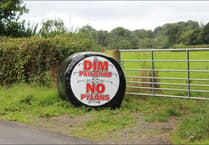In the normal course of events, you’d know when you were financing a dodgy venture. It’s hard to imagine your money being ploughed into an enterprise doomed from the start and being ignorant of the fact.
So how many of us knew we’re bankrolling an outfit with a boat in the Irish Sea embarked on a mission guaranteed to be a very bad idea all round?
The craft in question operates with a simple instruction: to blast off underwater seismic guns - to the certain detriment of dolphins and porpoises - as part of a madcap exercise to find a subterranean cemetery for large amounts of lethal radioactive waste from Cumbria’s Sellafield nuclear site.
I refer to pollutants that, for the last 70 years, have contaminated seas off vast coastal areas of Wales and Ireland, and parts of England, with radioactive substances that take, literally, tens of thousands of years to decay.
Let me introduce Nuclear Waste Services, an entirely taxpayer-funded public body under the wing of the UK government, which is engaging marine geological surveyors to comb the seabed for an out-of-sight-out-of-mind repository for the terrifying remnants of a dangerous and long discredited system of energy-generation.
Yes, the UK is looking for a storage site for the world’s biggest stockpile of untreated nuclear waste, including 100 tonnes of plutonium.
Currently the search centres on the seabed off Cumbria. The nearby notorious Sellafield nuclear complex having, since 1952, openly discharged substantial quantities of liquid and solid radioactive waste into the Irish Sea, a disreputable industry’s servants are now embarked on a final fling, dressed up, naturally, as a service to the UK population.
Thus Chris Eldred, a Nuclear Waste Services senior manager, expounding on the benefit of the gorgeously clinically named geological disposal facilities (GDFs) his company has set its heart on.
GDFs, he vouchsafes, “will protect future generations from the risks of keeping hazardous radioactive waste in surface stores for thousands of years.” Thank goodness, therefore, that we have the sea at our unfettered disposal, there to hide away nuclear power’s abiding torment - what to do with the reverberating remnants of a spent technology that will never in thousands of years be stilled.
“To help us with this vital work”, Mr Eldred says, “we will undertake surveys to provide a better understanding of the deep geology beyond the coast, while doing everything we can to minimise any environmental impact.”
In his apparent innocence, you wonder whether he has in mind earplugs for dolphins and porpoises, which are observed to be disorientated, distraught and damaged by the monstrous decibels of seismic guns. These theoretically protected animals, let it be remembered, are in all probability some of those we marvel at off the Ceredigion coast.
Not that the UK government or Nuclear Waste Services or anyone else has checked with us, the funders of this desperate exploration.
Not that they have seen fit, either, to mention that sea-borne radioactive waste, pumped for seven decades into the sea at Sellafield, has been detected off coasts of Wales, as well as hundreds of miles further south and west of the Cumbria nuclear site.
We’re talking here about insoluble radionuclides, such as highly dangerous plutonium-239, which has a half life of, truly, 24,110 years and can attach to particles in the sea, there to be transported over long distances and timescales and ultimately deposited into fine sediments. such as estuarine and coastal mudflats and salt-marshes. Since the early 1950s, this stuff has floated unhindered down from Sellafield off Wales’s west coast, ending up as far away as the Bristol Channel and the southern North Sea.
Sellafield’s tentacles have even reached inland Wales. In the late 1980s, the then Dyfed County Council commissioned a study of radioactivity in the county which found Caesium-137 - proved to have come from Sellafield sea discharges - in pasture grass seven miles inland from the Cardigan Bay coast. Radiocaesium, which has a 30-year half-life, can increase the risk for cancer.
The size of the current nuclear power-station decommissioning conundrum is mind-boggling. Even the UK government admits the seabed dump site it seeks for the world’s largest stockpile of untreated nuclear waste would need to keep its terrible debris “safe and secure over the hundreds of thousands of years it will take for the radioactivity to naturally decay”.
Meanwhile, councils signed up to the Nuclear Free Local Authorities grouping, including Ceredigion’s and Gwynedd’s, believe the pretty well obvious: no matter how effective the marine storage barriers, some radioactivity would eventually leak to the surface of the sea. They prefer the idea of a “near surface, near site storage of waste” to allow for monitoring and management.
Trying to show willing, they’re seizing on a least-worst option, which is nevertheless woefully inadequate.
The trouble is that nuclear-power adherents are now seriously contemplating for future generations a ghastly rerun of the decommissioning nightmare. Small-to-medium-sized reactors, such as envisaged for Trawsfynydd and Wylfa, are the smart way forward, they chorus. Once more, the probably insoluble decommissioning and nuclear waste-management problem is being blanked out.
All that’s left is for the realists among us to resolve, very firmly, that we will never allow a return to the insanity of a 1950s future.




